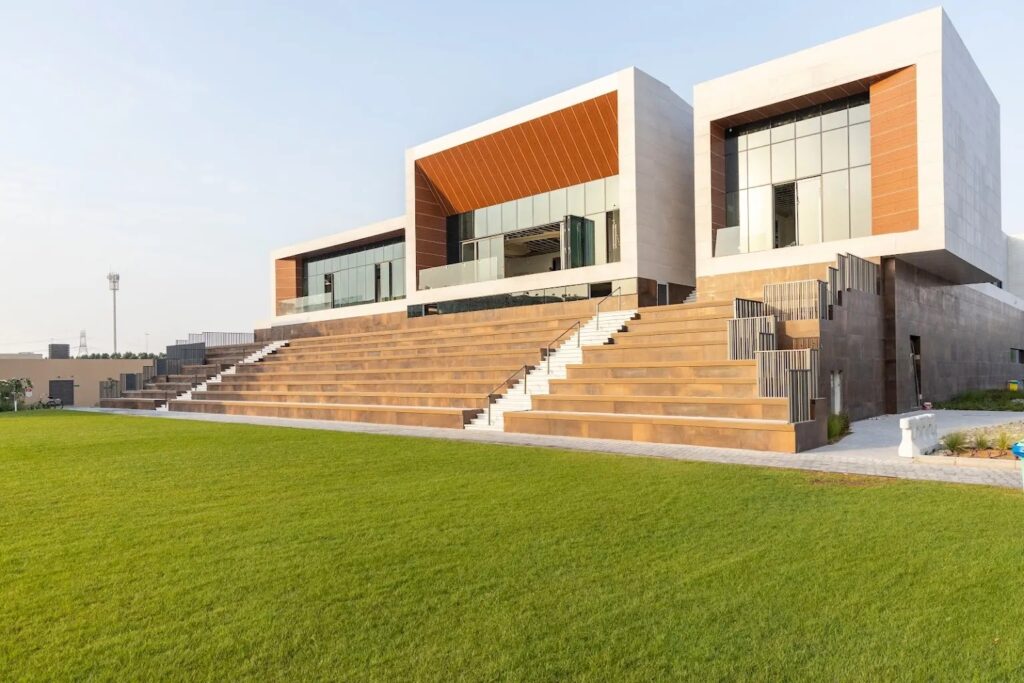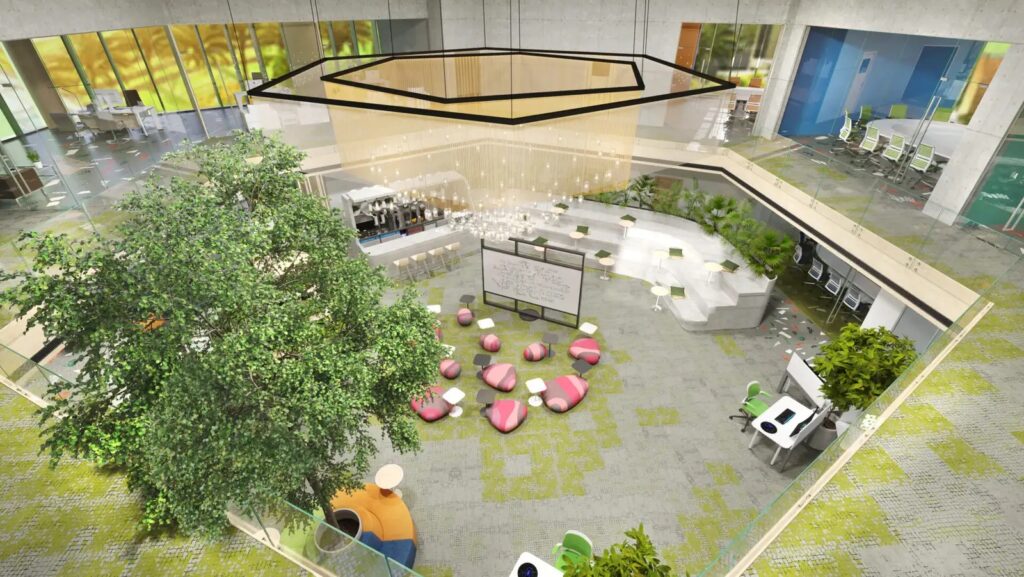The SEE Institute is a flagship for net zero buildings in Dubai Sustainable City, an environmentally responsible mixed-use and residential district in the desert. The 50,000 square foot net zero commercial building will be dedicated to the advancement of sustainability knowledge, technology, and innovations through research, training, events and incubation of tech startups working on solutions promoting social, environmental, and economic (SEE) sustainability.
Completed in 2020, the state-of-the-art building was unveiled at the WETEX & Dubai Solar Show, a major annual trade exhibition organized by Dubai Electricity and Water Authority (DEWA). Diamond Developers is behind the SEE Institute and The Sustainable City in Dubai, a successful project which is being replicated in other Emirates – Sharjah and Abu Dhabi, as well as neighbouring Oman.

Energy Generation
The SEE Institute generates more than 300% of its operational energy requirements through on-site renewable sources including solar panels and a biogas plant handling organic waste. After satisfying 100% of operational energy needs, a further 150% is used to offset emissions from commuting employees, water desalination, and consumable products that operate the Institute. Diamond Developers then supply the remaining 50% to neighbouring buildings to enable the SEE Institute to become carbon positive.
Almost 1 MWp (971.95 kWp) of solar PV panels were installed on the facility's car park shades and rooftops. Utilizing bi-facial solar panels (that absorb light on both sides) and white roofs the building is able to maximize energy generation from Dubai’s intense solar radiation.
The building also uses “smart cladding”, also known as Building-Integrated Photovoltaics (BIPV), on the south-facing wall. The PV panels look like normal cladding, customized to mimic the color and pattern of the rest of the façade while also generating clean energy.
The produced solar energy is fed into the Institute and the adjacent building, a short-term accommodation called The Sustainable Homes, consisting of 51 studio apartments. The existing net metering supports any surplus energy to go to the grid, thus contributing to a cleaner national energy mix.
A small-scale biogas plant using anaerobic digestion is designed to handle up to 3,000 kg of organic waste per day from the neighborhood to produce biogas and a digestate. There is no combustion involved and digestion produces approximately 321 m3/day of biogas to serve a direct-fired absorption chiller that covers around 39% of the building’s cooling load.

Energy Efficiency
SEE Institute employed an integrated approach to energy demand-side management through passive and active design strategies, to achieve 100 kWh/m2/year of Energy Use Intensity. Energy modelling was used in the design phase to estimate the annual energy consumption of the building, which then informed decisions on its orientation and geometry, as well as construction materials, mechanical infrastructure, and electrical systems.
Diamond Developers considered several external wall and façade options, prioritizing operational performance, namely insulation and acoustic values, as well as sustainability, and cost. A new generation of window glazing was selected, using coated glass to ensure solar protection and strong thermal insulation in order to minimize air-conditioning use. The glazing has a U-value of 1.5 W/m2K, which is 20% lower than the values proposed by Al Sa’fat, the Dubai Green Building Regulator (1.9 W/m2K).
The light transmittance of the glazing is 75%, meaning it provides sufficient daylight for spaces and a clear unaltered view for occupants. Supplementary illumination is provided by an intelligent LED lighting system that uses sensors placed in the fixtures to detect available daylight and the presence of people to automatically reduce the amount of light needed.
A Building Management System was implemented in the building to control and operate systems efficiently, such as chillers, fresh air handling units and power consumption units, water leakage detection, lighting, air quality, solar PV and EV charging points, lifts, and fire alarms.

Embodied Carbon
The SEE Institute followed Dubai regulator Al Sa’fat’s guidelines as it worked towards reducing its embodied carbon as much as possible throughout the entire process. Further to this, the building is registered under the ILFI Zero Carbon certification program, which addresses both embodied and operational carbon and calls for reducing and offsetting emissions associated with materials, construction, and overall energy consumption.
All the construction materials were sourced locally to minimize transportation emissions. Key decisions during the construction phase assisted in reducing 26% of the project’s embodied carbon, which also significantly contributes to reducing overall project GHG emissions.
Thermal-insulated blocks served as a benchmark as one of the most popular options for external wall construction, following a life cycle assessment of all materials. The lightweight façade was chosen for its low U-value and higher sound isolation. The façade has a U-Value of 0.22 W/m2K which is 50–70% better than regulator requirements and guarantees better performance during the operational phase of the building.
Through these measures, the SEE Institute achieved an embodied carbon value of 500 kgCO2e/m2, accounting for emissions stemming from onsite machinery fuel usage.
Net Zero Buildings Environment
In 2006 the World Wildlife Fund (WWF) declared the United Arab Emirates the country with the largest ecological footprint, per capita, in the world. This can be credited to its rapid development as well as high GDP lifestyles and a harsh climate. Dubai’s current ruler, Sheikh Mohammed bin Rashid Al Maktoum, took over in 2006 and soon decreed that his city would strive for 75% of its energy to come from clean sources by 2050. Building regulation and support programs have become a big part of achieving that goal.
Founded in 2011, the Dubai Green Building Guide and Regulations are a framework designed to create a sustainable city. No credits, points, or certifications are awarded in the program. Dubai Municipality simply obliges all developers, consultants, designers and industry stakeholders to follow the Green Building Regulations and Specifications as a condition for acquiring a building permit.
Built for purpose but also as a showcase for Diamond Developers Sustainable City projects, the SEE Institute exceeded all the requirements set by the environmentally ambitious Dubai regulators. Whatever the motivations, the building is a model for the net zero buildings community in the way it maximized energy generation to cover every corner of the net zero spectrum.
Moreover, by supplementing the building's operational systems with innovative passive design, cladding, and glazing features they further drive the excess electricity needed to exceed net zero with carbon-positive status. If one-third of the world’s buildings were like this one, then the buildings sector would be net zero.



